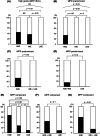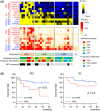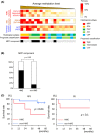Association of frequent hypermethylation with high grade histological subtype in lung adenocarcinoma
- PMID: 37082886
- PMCID: PMC10323093
- DOI: 10.1111/cas.15817
Association of frequent hypermethylation with high grade histological subtype in lung adenocarcinoma
Abstract
Lung adenocarcinoma is classified morphologically into five histological subtypes according to the WHO classification. While each histological subtype correlates with a distinct prognosis, the molecular basis has not been fully elucidated. Here we conducted DNA methylation analysis of 30 lung adenocarcinoma cases annotated with the predominant histological subtypes and three normal lung cases using the Infinium BeadChip. Unsupervised hierarchical clustering analysis revealed three subgroups with different methylation levels: high-, intermediate-, and low-methylation epigenotypes (HME, IME, and LME). Micropapillary pattern (MPP)-predominant cases and those with MPP components were significantly enriched in HME (p = 0.02 and p = 0.03, respectively). HME cases showed a significantly poor prognosis for recurrence-free survival (p < 0.001) and overall survival (p = 0.006). We identified 365 HME marker genes specifically hypermethylated in HME cases with enrichment of "cell morphogenesis" related genes; 305 IME marker genes hypermethylated in HME and IME, but not in LME, with enrichment "embryonic organ morphogenesis"-related genes; 257 Common marker genes hypermethylated commonly in all cancer cases, with enrichment of "regionalization"-related genes. We extracted surrogate markers for each epigenotype and designed pyrosequencing primers for five HME markers (TCERG1L, CXCL12, FAM181B, HOXA11, GAD2), three IME markers (TBX18, ZNF154, NWD2) and three Common markers (SCT, GJD2, BARHL2). DNA methylation profiling using Infinium data was validated by pyrosequencing, and HME cases defined by pyrosequencing results also showed the worse recurrence-free survival. In conclusion, lung adenocarcinomas are stratified into subtypes with distinct DNA methylation levels, and the high-methylation subtype correlated with MPP-predominant cases and those with MPP components and showed a poor prognosis.
Keywords: DNA methylation; high-grade subtype; histological subtype; lung adenocarcinoma; micropapillary component.
© 2023 The Authors. Cancer Science published by John Wiley & Sons Australia, Ltd on behalf of Japanese Cancer Association.
Conflict of interest statement
A.K. is an Associate Editor of Cancer Science, and all other authors have no conflict of interest.
Figures






Similar articles
-
Adenocarcinoma of the stomach and esophagogastric junction with low DNA methylation show poor prognoses.Gastric Cancer. 2023 Jan;26(1):95-107. doi: 10.1007/s10120-022-01344-3. Epub 2022 Oct 12. Gastric Cancer. 2023. PMID: 36224483
-
A low DNA methylation epigenotype in lung squamous cell carcinoma and its association with idiopathic pulmonary fibrosis and poorer prognosis.Int J Cancer. 2020 Jan 15;146(2):388-399. doi: 10.1002/ijc.32532. Epub 2019 Jul 8. Int J Cancer. 2020. PMID: 31241180
-
DNA methylation epigenotype and clinical features of NRAS-mutation(+) colorectal cancer.Cancer Med. 2017 May;6(5):1023-1035. doi: 10.1002/cam4.1061. Epub 2017 Apr 4. Cancer Med. 2017. PMID: 28378457 Free PMC article.
-
Two groups of DNA methylation markers to classify colorectal cancer into three epigenotypes.Cancer Sci. 2011 Jan;102(1):18-24. doi: 10.1111/j.1349-7006.2010.01712.x. Cancer Sci. 2011. PMID: 21159060 Review.
-
Both the presence of a micropapillary component and the micropapillary predominant subtype predict poor prognosis after lung adenocarcinoma resection: a meta-analysis.J Cardiothorac Surg. 2020 Jun 29;15(1):154. doi: 10.1186/s13019-020-01199-8. J Cardiothorac Surg. 2020. PMID: 32600473 Free PMC article. Review.
Cited by
-
Epigenetic characterization of housekeeping core promoters and their importance in tumor suppression.Nucleic Acids Res. 2024 Feb 9;52(3):1107-1119. doi: 10.1093/nar/gkad1164. Nucleic Acids Res. 2024. PMID: 38084904 Free PMC article.
-
Impact of lung adenocarcinoma subtypes on survival and timing of brain metastases.Front Oncol. 2024 Sep 3;14:1433505. doi: 10.3389/fonc.2024.1433505. eCollection 2024. Front Oncol. 2024. PMID: 39290244 Free PMC article.
-
Methylation-related differentially expressed genes as potential prognostic biomarkers for cervical cancer.Heliyon. 2024 Aug 14;10(17):e36240. doi: 10.1016/j.heliyon.2024.e36240. eCollection 2024 Sep 15. Heliyon. 2024. PMID: 39263148 Free PMC article.
-
RNA sequencing identifies lung cancer lineage and facilitates drug repositioning.PeerJ. 2024 Sep 24;12:e18159. doi: 10.7717/peerj.18159. eCollection 2024. PeerJ. 2024. PMID: 39346064 Free PMC article.
-
Research Progress of Liquid Biopsy Based on DNA Methylation in Tumor Diagnosis and Treatment.Biomolecules. 2024 Dec 19;14(12):1634. doi: 10.3390/biom14121634. Biomolecules. 2024. PMID: 39766341 Free PMC article. Review.
References
-
- Ferlay J, Colombet M, Soerjomataram I, et al. Estimating the global cancer incidence and mortality in 2018: GLOBCAN sources and methods. Int J Cancer. 2019;144:1941‐1953. - PubMed
-
- Travis WD, Brambilla E, Burke A. WHO Classification of the Tumours of the Lung, Pleura, Thymus and Heart (eds 4). IARC Press; 2015. - PubMed
-
- Warth A, Muley T, Meister M, et al. The novel histologic International Association for the Study of Lung Cancer/American Thoracic Society/European Respiratory Society classification system of lung adenocarcinoma is a stage‐independent predictor of survival. J Clin Oncol. 2012;3013:1438‐1446. - PubMed
MeSH terms
Substances
Grants and funding
LinkOut - more resources
Full Text Sources
Medical
Molecular Biology Databases

